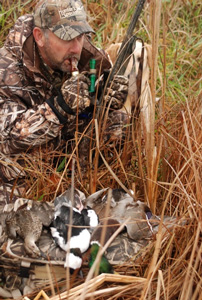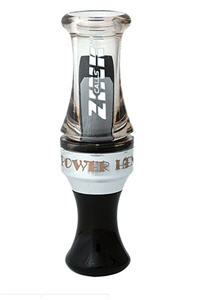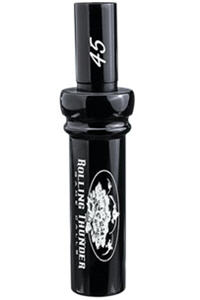
 Whether you are an octogenarian duck hunter or planning your very first waterfowl hunting trip, selecting a duck call from the hordes of fine instruments on the market today can be a daunting task. This guide will you shorten the selection process considerably.
Whether you are an octogenarian duck hunter or planning your very first waterfowl hunting trip, selecting a duck call from the hordes of fine instruments on the market today can be a daunting task. This guide will you shorten the selection process considerably.
Duck hunters are like musicians: they all have their favorite old instrument which they like to play regularly. However, hunter and music aficionados like to keep up on what is new, which has become more and more complicated with the advent of new products every year.
Basic Call Types
Duck calls come in single and double reed models. Single reed calls are the first choice of most of the "professional callers," because once you master the single reed call, you can sound like more than one duck in the same calling series. Too, single reed calls generally produce more volume and are great for long range calling situations. However, they can still be toned down for close in calling situations.
If you are a beginning duck caller, or simply do not want to practice much, a double reed call is probably best for you. Today, many quality double reed calls are capable of producing volume close to that of single reed calls. Double reeds are generally manufactured to be a loud call or a soft call. You will not be able to change pitches as easily with them, nor will you be able to sound like more than one duck as easily in the same calling series. A major disadvantage of double reed calls is their nasty nature for the two reeds to stick together in temperatures slightly above freezing.
Most older generation waterfowl hunters are still fond of the old wooden calls. I carried an old, walnut, duck call for decades because of the way the wood smelled. And the more I handled the walnut call the more beautiful it became. The oils from hands polished the call. However, when it began to sound more like a dying chicken rather than a real duck, I retired it to shelf at home.
Wood is wonderful for as long as it lasts. They produce very mellow tones, but the tone will begin to change as soon as the sounding board gets wet. If you purchase a wood call, make sure it has a brass or steel ring around the barrel to keep it from splitting. Eventually it will swell with moisture, shrink with drying and then become useless as a duck calling tool. I still like to carry one on my lanyard to play with during hunting lulls.
The denser the material from a duck call is made, the louder and crisper duck sounds will be from the call. The least expensive and most durable call is made of polycarbonate. Acrylic calls, which are more expensive, produce sharper sounds, which will not change with usage. Polycarbonate duck calls are manufactured via a mold. Acrylic calls are turned on a lathe allowing for tighter tolerances. Call makers generally fine tune these higher priced calls before shipping them to distributors.
Types of Duck Calls
The type of duck call which you decide to purchase should be one that fits your intended purpose of use. Experienced duck hunters will readily tell you that if you do a lot of duck hunting you will encounter many different scenarios, which require a variety of duck calls. However, do not buy a bunch of calls at the beginning of your duck hunting career. Start small and add to your arsenal as you determine your needs. It is best to start with a low to mid-range call, because it is wise to call too softly rather than too loudly. Overcalling and utilizing too much volume is a common error among duck hunters.
Open Water Calls are built for large, open areas and great for windy conditions. They can achieve high volumes which are necessary to attract migrating ducks are ducks which are demonstrating aggressive calls in response to your calling sequences. These calls are designed to make a lot of noise and will not produce the softer ducks sounds without a lot of practice from the caller. Bass Pro Shops carry an unbelievable variety of duck calls. Among the open water calls you will find: Zink's Call Power Hen, Echo Calls' XLT Acrylic, Duck Commander's Jase Robertson Pro Series Tigerwood call and Rich-N-Tone Original Acrylic Duck Call. These are just a place to start looking.
Timber Calls are designed for tighter places such as closed in areas, heavy timber and very calm days. These quieter calls are marvelous for calling ducks which have been highly pressured. They also work well when hunting ducks over ice. Timber calls are often use don big water, too, when finicky ducks need a soft finishing call to get them to make the final commitment. Excellent timber calls which you will find at Bass Pro Shops include: Echo's Acrylic Timber Duck Call and Echo Polycarbonate Timber Single Reed Duck Call, Hayes Burning Timber Duck Call and Duck Commander's Uncle Si Call.
Cutdown Calls are growing rapidly in popularity. These calls are made to be very loud, with a distinctive sound. The term "cut-down" came from the habit of hunters trimming and rounding the reeds of the old, original Olt duck calls, which had a curved tone board below a straight reed. These alterations gave hunters a call with greater volume and a wider variety of pitches. Many varieties of these calls are on the market and more appear each season from local call makers. At Bass Pro Shops, look for Rolling Thunder Original Cutdown Duck Call, Haydel's Big Barrelled Cutdown Mallard Duck Call, and Rolling Thunder 45 Cutdown Duck Call.
Despite all of the glamour surrounding duck calls, most duck hunters will select a call that sounds good to them. If it looks really sharp, that is even better. And regardless of how many calls you decide to hang on your lanyard, the one that you will use the most is the one that brings home the most ducks.
- 29511 views





